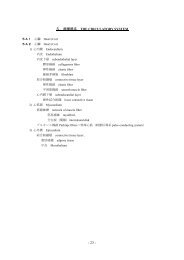Program / Abstract Book - KMU WWW3 Server for Education ...
Program / Abstract Book - KMU WWW3 Server for Education ...
Program / Abstract Book - KMU WWW3 Server for Education ...
Create successful ePaper yourself
Turn your PDF publications into a flip-book with our unique Google optimized e-Paper software.
No. 95 (PO 9)<br />
Number and morphology of mesothelial cells in peritoneal dialysis effluent as a<br />
potential predictive marker <strong>for</strong> advanced peritoneal dysfunction<br />
Mayumi Idei 1 , Yoko Tabe 1 , Kazunori Miyake 1 , Chieko Hamada 2 , Hiroyuki Takemura 3 , Hiroaki<br />
Io 2 , Kiyoshi Ishii 3 , Takashi Horii 3 , Yasuhiko Tomino 2 , Akimichi Ohsaka 3 , Takashi Miida 1<br />
1, Department of Clinical Laboratory Medicine, Juntendo University School of Medicine, Tokyo, Japan<br />
2, Division of Nephrology, Department of Internal Medicine, Juntendo University School of Medicine ,<br />
Tokyo, Japan<br />
3, Division of Clinical Laboratory, Juntendo University Hospital, Tokyo, Japan<br />
Encapsulating peritoneal sclerosis (EPS) is a serious complication of peritoneal dialysis (PD). A risk<br />
of EPS increases with a development of peritoneal dysfunction where increased peritoneal permeability<br />
is associated with exfoliation and loss of peritoneal mesothelial cells.<br />
In this study, we investigated whether the number and morphology of mesothelial cells in peritoneal<br />
dialysis effluent (PDE) reflect a peritoneal function, and predict increased susceptibility to EPS.<br />
Materials and Methods: PDE samples were obtained from 33 PD patients (26 men, 7 women, PD<br />
duration; 29.1 ± 27.4 months) with peritoneal equilibration test (PET) per<strong>for</strong>med. The number of<br />
mesothelial cells was counted in 36 mm 2 area of slide preparation. According to the classification of cell<br />
morphology based on the life-cycle of mesothelial cells, mesothelial cells were classified into quiescent,<br />
activated, phagocytic, and degenerating cells with the digital microscopy system CellaVision DM96.<br />
PET was used to categorize patients into four transporter groups; high (H), high average (HA), low<br />
average (LA), and low (L).<br />
Results: The number of mesothelial cells in PDE samples was significantly lower in H transporter<br />
group than HA (p < 0.05). Mean numbers of mesothelial cells were 2.7 ± 0.6 <strong>for</strong> H transporter group<br />
(n=3), 15.8 ± 11.4 <strong>for</strong> HA (n = 16), and 14.8 ± 21.7 <strong>for</strong> LA (n = 11), and 11.3 ± 12.9 <strong>for</strong> L (n=3),<br />
respectively. In morphological analysis, whereas both quiescent- and activated- mesothelial cells were<br />
present in HA, LA, and L transporter groups, in H transporter group, however, quiescent cell type was<br />
predominantly observed.<br />
Conclusions: Decreased number of mesothelial cells in PDE of a high transporter membrane state,<br />
suggesting the loss of peritoneal mesothelial cells during chronic peritoneal injury, might be a<br />
convenient and useful predictive marker <strong>for</strong> advanced peritoneal dysfunction.<br />
- 148 -



